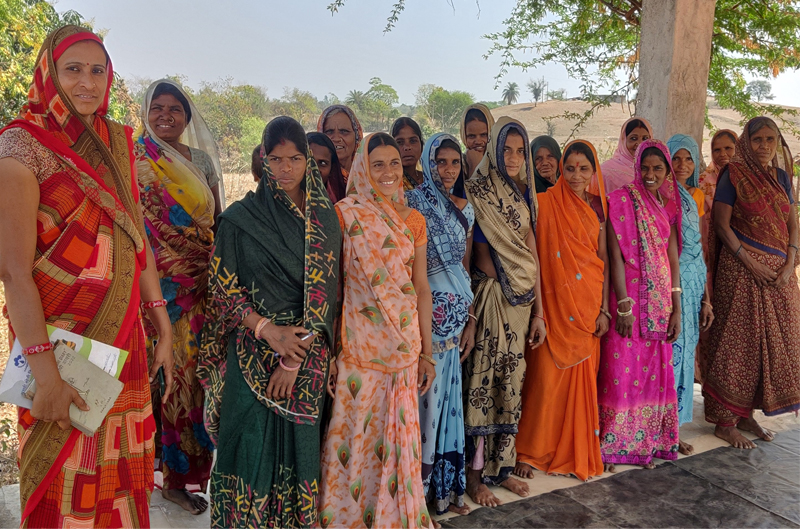A voluntary organisation has been working to strengthen the self-reliance of rural communities, particularly tribal ones, and the results are attracting wide notice. Vaagdhara works with many such communities at the junction of the states of Rajasthan, Madhya Pradesh and Gujarat, and it has planned and implemented a number of creative initiatives relating to farming, water, afforestation, education, childhood, health, nutrition and other related issues. Bharat Dogra describes the efforts made by the organisation and the success it has achieved
In recent years, the efforts of the Vaagdhara voluntary organisation in Central India related to strengthening the self-reliance of rural communities, particularly tribal ones, have been attracting increasing attention, as they have been able to increase the resilience of these communities by enabling more of their needs to be met through sustainable and environment-friendly livelihoods.
This is linked closely to the concept of gram swaraj or village self-reliance, which was an important component of Mahatma Gandhi’s struggle against colonial rule. Several disciples of Mahatma Gandhi kept alive this concept in the post-Independence period, albeit in limited ways. Though with globalisation it has become difficult to maintain the true spirit of the idea, even in these times, the concept of self-reliance is part of the thinking of several tribal communities.
Vaagdhara works with many such communities at the junction of the states of Rajasthan, Madhya Pradesh and Gujarat, and it has planned and implemented a number of creative initiatives relating to farming, water, afforestation, education, childhood, health, nutrition and other related issues. In light of the looming environmental crisis, people worldwide are looking beyond quick-fix solutions to find alternative ways of thinking and living, which will lead to a more durable way of preventing the worst of the crisis. In this context, Vaagdhara’s work with tribal communities in India and elsewhere, based on a better understanding of community strengths, has a wider and more important appeal and relevance.
The communities experienced erosion and even disruption of their integrated, inter-related systems under colonial rule and even later. The weakened communities were less able to cope with droughts and other adverse weather conditions. This forced many of their members to become migrant workers for survival. This further eroded their bonds with the community and affected the continuation of traditions and learnings. While basic community traditions remain in place in most villages, several strengths have been weakened. This is why a process based on first understanding communities and then helping to strengthen them is desirable.
Vaagdhara’s members approach communities with this spirit of learning and understanding, and it has enabled them to grasp the many virtues of community land use and farming practices keeping in view local conditions, strengths and constraints. Based on this understanding, they are better able to decide what kind of action would be most beneficial, and what should be avoided. Following this path, Vaagdhara members approached several households who had become dependent on migrant work in distant cities, to find out whether they were keen to return to their neglected farmlands, and if yes, what kind of help they required during the transition period.
Amrit Lal wanted seeds, saplings and some hand-holding to help overcome any temporary crisis due to his loss of wages as a migrant worker when he returned to his family farm in Bhundri Village of Banswara District. Once the first year of transition was completed, there was no going back. Amrit Lal now grows a variety of grains, vegetables, fruits, spices and other crops, following natural farming methods. He has received an award for motivating villagers to grow thousands of trees. He has come a long way from a struggling migrant labourer, and his wife Surta is very happy that the family is once again united, and working together in creative ways.
After meeting this family, this writer also met a women’s group, called Saksham Samooh, in Nagli Sera Village of the same district. Almost all the women had stories to relate about improved economic conditions based on increasing self-reliance via growing mixed crops with the focuson their food needs. One woman, named Susheela, said, with the exception of salt and edible oil, she was able to produce all the food she needed on her farm.
Saving traditional seeds is an important part of the self-reliance. Apart from this being encouraged at the village-level, Vaagdhara recently organised seeds-protection festivals at about 90 places, to which people came to meet others and share information and seeds. Food festivals are also organised to share information about traditional nutritious foods which have been falling into obscurity. Recipes and also cooked food are shared at these festivals, much to the delight of children.
Vaagdhara emphasises that children should not be alienated from their communities as they grow up, with the hope that as they acquire more learning, they can come back to their communities to serve as teachers, doctors, or in other ways. While villages have swaraj groups and saksham groups, there is also a forum for tribal community development initiatives called Janjati Vikas Manch, which takes up wider mobilisation tasks. Such as approach of understanding traditional strengths of communities and then trying to revive and improve them in difficult times is a valuable contribution at the local level, besides keeping alive thought and livelihood patterns that are in tune with environment protection and sustainable livelihood.
(The writer is a senior freelance journalist and author who has been associated with several social movements and initiatives. He lives in New Delhi.)



 from Webdoux
from Webdoux